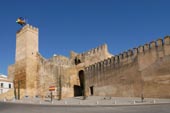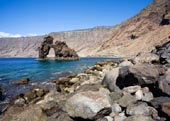Visitors finding it a little strange when arriving at Murcia airport and noting that the airport is actually a long way from Murcia itself, will be pleased to know that there is now a new Murcia airport being built at Corovera in the Sierra de Carrascoy, however they may not be so pleased when they realise that this airport is also going to be at least a 20 minute drive from the city itself. Of course the vast majority of arrivals at Murcia (San Javier) airport are actually heading for the coastal resorts of the northern Costa Calida and southern Costa Blanca, so San Javier, site of the existing Murcia airport, is actually better placed than the new airport for these visitors. Plans for the airport were first discussed in 2005 and despite objections to the construction, work has continued, and the new airport is due to be completed in 2010 at a cost of 266 million euros. Whether you are arriving at the existing airport or the new one when it opens, you will probably need to book car hire to get you to your resort and then around the area to make the most of your stay, other options include taxis, or a pre-booked airport transfer, in both cases once you arrive at your resort you will be somewhat confined to that immediate area if you have not booked a car hire vehicle, so you had better check that your destination accommodation is within easy reach of local facilities and beaches or you could be in for a long walk.
November 29, 2009
November 20, 2009
Carmona Andalucia

Seville Gate Carmona
A historic town in south-western Spain, Carmona is situated in the Seville province of Andalucia and has a population of around 27,000. Gathered around a ridge overlooking Andalucia’s central plain, Carmona has a history stretching back to the times of the ancient Romans, and the remains of a Roman necropolis just outside the town are among its great tourist attractions today. Carmona was an important city around the time of Julius Ceasar, and continued to be important after the arrival of the Moors in Spain. The Moors built fortified walls around the town and built palaces and fountains within its walls. Arab control of Carmona ended in 1247 after Ferdinand III of Castille invaded and took the city back for the Christians. Modern day Carmona is a popular tourist destination with good road and bus links with the city of Seville, around 40km to the west. Carmona Map.
November 17, 2009
Santiago de Compostela Galicia
One of the world’s Holy Cities, Santiago de Compostela, located in Spain’s Galicia region is a great city to visit, has some interesting historic buildings, and has a wonderful story to tell. Supposedly the burial place of St James the Apostle in AD44, it became a place of pilgrimage after the rediscovery of his remains by a religious hermit in the 9th century. The original Basilica built by Alfonso II, was replaced by the present cathedral during the 11th to 13th centuries. The cathedral and most of the historic buildings are gathered around the Praza do Obradoiro, and this is a good place to start a visit to the city. Other interesting places to visit in Santiago de Compostela include the Pazo de Raxoi, the Casa do Cabildo and the Museo da Catedral. The climate of the city is mixed, with the weather generally sunny and warm during the summer, but very rainy during the winter, with 1,900mm of rain annually it is one of Europe’s rainiest cities, the Galicia region is in fact one of the greenest in Spain.
November 15, 2009
Las Vegas Trip 2009

Gill Travelling in Las Vegas Style
Just a short post to celebrate our trip to Las Vegas in September 2009. I am still sorting through the photos ( I took over 500!) and it is taking more time than I have to spare at the moment. I am trying to organise everything into a little website which may be of use to others travelling to Las Vegas and also of interest to the 20 or so members of the Pilar badminton club (and friends), with whom we travelled (is it whom or who?). The trip organised by Kitty was a great success and I think everyone had a great time, even if it did prove to be a little more expensive than expected (the prices in Las Vegas have apparently soared in the last couple of years). The picture shown is of my wife Gill, travelling in the style with which she would like to be accustomed! I shall be posting lots more pictures here (when I get the time), but you might find the website interesting as it has a Las Vegas map, which is interactive and very handy if you are driving around Las Vegas, and the current Las Vegas weather, so you can see what to expect if you are visiting….more on Las Vegas later.
November 11, 2009
Yaiza Lanzarote
Heading from Playa Blanca towards the Parque Nacional de Tinamfaya, you will pass through the pretty town of Yaiza one of the most attractive on the island of Lanzarote in the Spanish Canary islands. Nestling at the foot of the Montañas del Fuego mountains, Yaiza is the main town for the municipality which covers south-western Lanzarote. Partly destroyed by the great volcanic eruption during the 1730’s, Yaiza’s inhabitants mostly left the town and headed further south for the village of Femes, the population not fully recovering until the 20th century. Notable places to visit in the town include the beautiful 18th century church of Nuestra Señora de los Remedios, built on the site of an earlier chapel with its colourful altarpiece, outside the town, of course, you can head for Timanfaya, one of Lanzarote’s premier tourist destinations. Yaiza is a peaceful place to stop for a drink or maybe a meal in one of the fine restaurants, there are also some excellent gift shops where you can purchase a souvenir or two from your visit. Yaiza Map.
November 10, 2009
El Hierro Canary Islands

Roque de Bonanza El Hierro Canary Islands
The most westerly and also the smallest of the major Canary Islands, El Hierro has a population of just 10,000, living on an island with an area of 278km2. A mountainous island with over 500 volcanic peaks, El Hierro was actually considerably bigger at one time, but lost a third of its area during a huge volcanic eruprion which took place 50,000 years ago. First settled by the Bimbache tribe, El Hierro later attracted the attention of Castillion and Norman sailors, who seized the island and sold the inhabitants into slavery. The main source of survival for the islanders over the years has been fishing and agriculture and even these days relies mostly on these as tourism has not really taken off on the island due mainly to the scarcity of beaches. The only town of any size on El Hierro is Valverde.